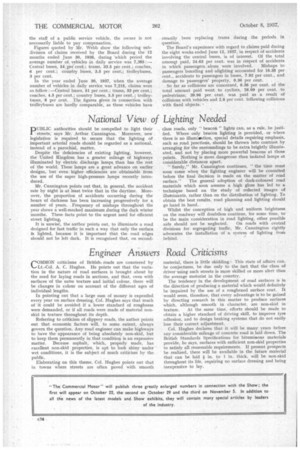National View of
Page 60

If you've noticed an error in this article please click here to report it so we can fix it.
Lighting Needed PUBLIC authorities should be compelled to light their streets, says Mr. Arthur Cunnington. Moreover, new, legislation is required to secure that the lighting of important arterial roads should be regarded as a national, instead of a parochial, matter.
Despite the deficiencies of existing lighting, however, the United Kingdom has a greater mileage of highways illuminated by electric discharge lamps, than has the rest of the world. These lamps are a great advance on earlier designs, but even higher efficiencies are obtainable from the use of the super high-pressure lamps recently introduced.
Mr. Cunnington points out that, in general, the accident rate by night is at least twice that in the daytime. Moreover, the proportion of accidents occurring during the hours of darkness has been increasing progressively for a number of years. Frequency of mishaps throughout the year shows a well-marked maximum during the dark winter months. These facts point to the urgent need for efficient street lighting, It is unwise, the author points out, to illuminate a road designed for fast traffic in such a way that only the surface is lighted, because it is important that the road edges should not be left dark. It is recognized that, on second class roads, only " beacon" lights can, as a rule, be justified. Where only beacon lighting is provided, or where there is no illtunimtion, special details requiring emphasis, such as road junctions, should be thrown into contrast by arranging for the surroundings to be extra brightly illuminated, and not by placing more powerful beacons at those points. Nothing is more dangerous than isolated lamps at considerable distances apart, " Surely," Mr. Cunnington continues, "the time must soon come when the lighting engineer will be consulted before the final decision is made on the matter of road
surface." The general adoption of dark-coloured road materials which soon assume a high gloss has led to a technique based on the study of reflected images of illuminants, rather than on the distribution of lighting. To obtain the best results, road planning and lighting should go hand in hand.
Whilst the conception of high and uniform brightness on the roadway will doubtless continue, for some time, to be the main consideration in road lighting, other possible aids should not be neglected. On roads with central divisions for segregating traffic, Mr. Cunnington rightly advocates the installation of a system of lighting from behind.




























































































